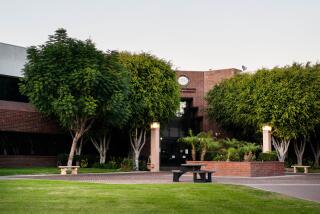WESTLAKE : School of Asian Medicine Moves
- Share via
The Samra University of Oriental Medicine, the oldest and largest such school in the United States, has moved from Beverly Boulevard to a larger building at 600 St. Paul Ave., just west of Downtown.
The move will enable the university to accommodate its growing student enrollment and the growth of its community clinic, said Timothy Timmons, the university’s academic dean.
Founded 25 years ago by Homer Cheng, a Chinese doctor trained in Western medicine, the institution was originally called the Sino American Medical Rehabilitation Assn. and was devoted to teaching Western doctors and missionaries how acupuncture could help stroke victims recover.
In the 1970s, when relations between the United States and China were reopened, many Americans in the health care field developed an interest in acupuncture, which involves the insertion of needles at specific points in the body as a means to relieve pain and treat certain diseases. Acupuncture has been used in China and other Asian countries for thousands of years.
In 1979, Samra University, which took its name from the initials of Dr. Cheng’s rehabilitation association, became the first school of Asian medicine to be fully approved by the state Department of Education.
Today the university has about 300 students from more than 25 countries studying for a master’s degree in Asian medicine. Classes are taught separately in English, Korean and Chinese. After completing their studies, students must pass a state licensing exam to practice.
Although Asian medicine is gaining acceptance, many Americans are still unfamiliar with it, Timmons said.
“We do more than just stick needles in people,” he said, adding that the curriculum also includes extensive instruction in the properties and use of herbs, nutrition, exercise therapy, massage, anatomy and physiology.
“What we’re seeing with President Clinton’s health care plan is a shift away from a reliance on high-tech machines and treatments toward a greater emphasis on primary care and low-cost modalities,” Timmons said. “There’s a boom in alternative health care and alternative therapies, and we’re a part of that.”
According to a January, 1993, study published in the New England Journal of Medicine, about one-third of Americans turned to some form of alternative medical treatment in 1990 and spent $13.7 billion on those treatments or therapies, which include herbal medicine, massage and acupuncture.
By calming the nerves, reducing the craving for drugs and easing the discomfort of withdrawal, acupuncture can prepare a patient for additional counseling and help in kicking an addiction, according to some studies.
Samra University also operates an herbal pharmacy that stocks more than 400 Chinese herbs and a community clinic, open seven days a week, where students treat patients under the faculty’s supervision and make referrals for patients who need additional treatments.
The clinic, open daily from 9:30 a.m. to 6 p.m., sees an average of 500 patients a month. After being shut down while the university moved, it will resume seeing patients Monday.
Information: for university matters, (213) 482-8448; for the clinic, (213) 482-9645.
More to Read
Sign up for Essential California
The most important California stories and recommendations in your inbox every morning.
You may occasionally receive promotional content from the Los Angeles Times.













